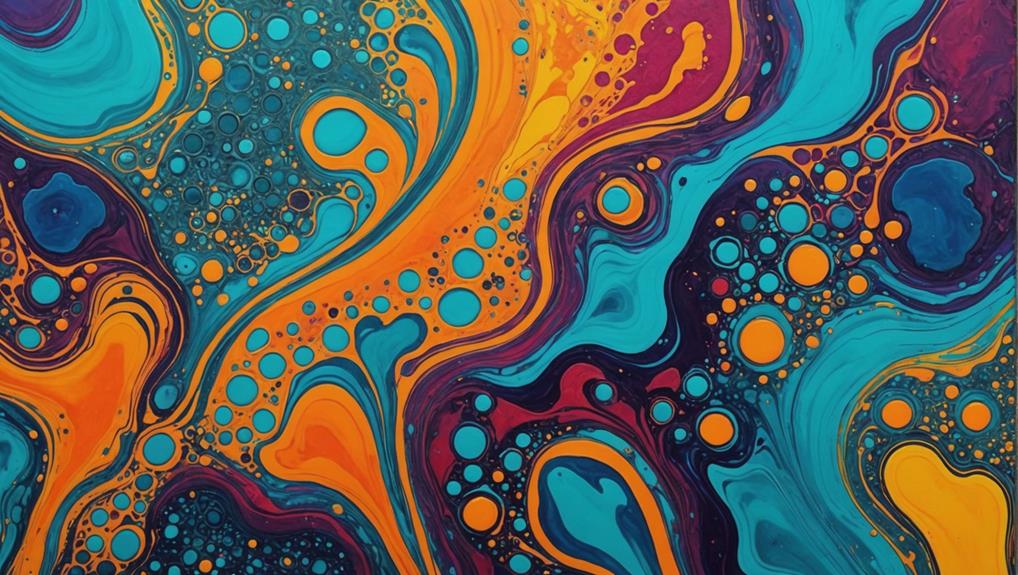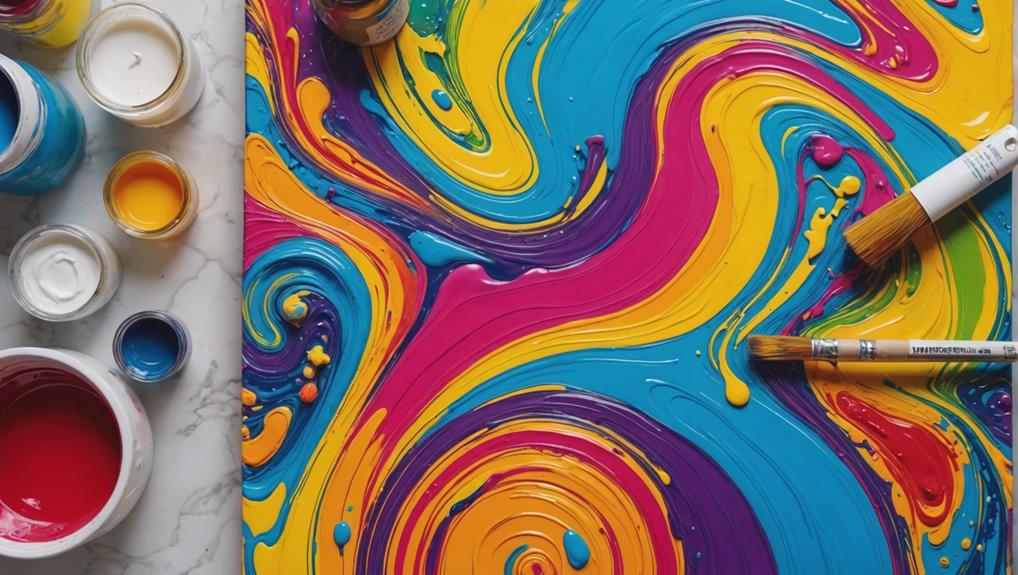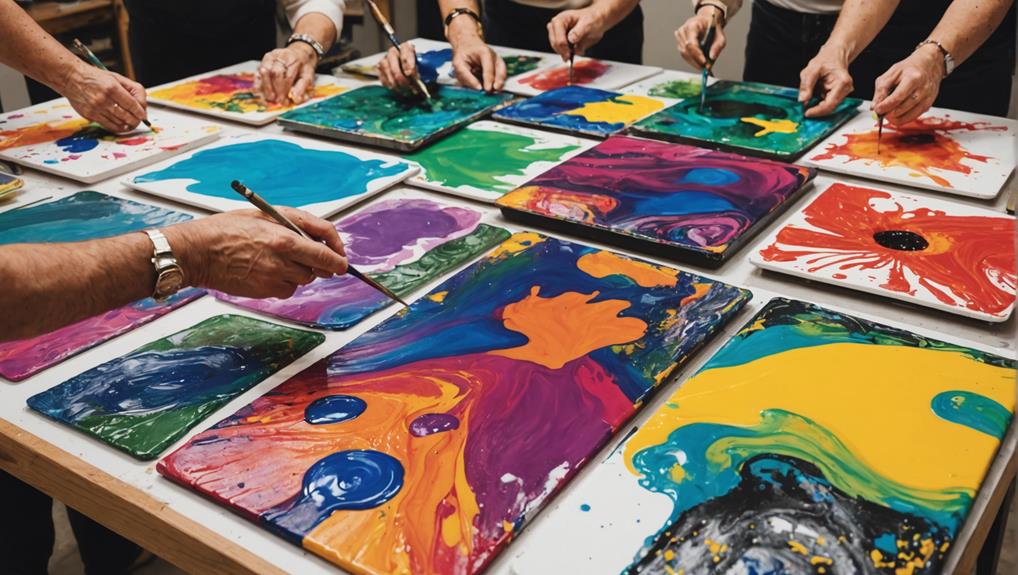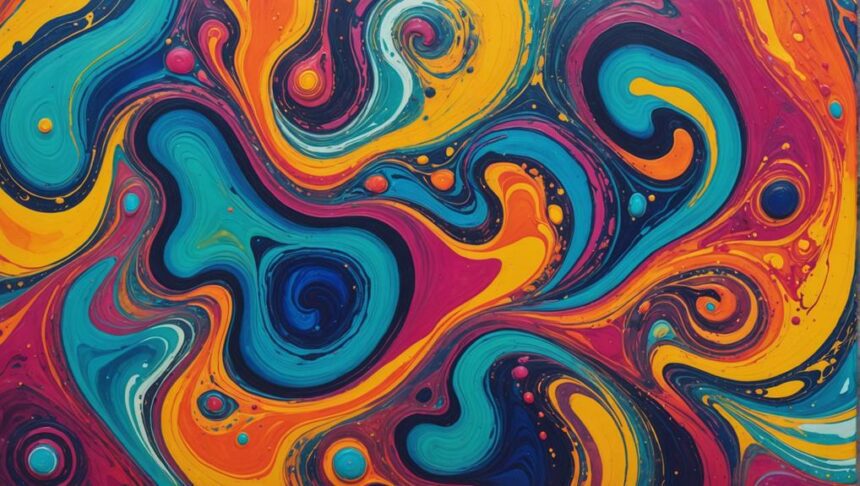Choosing the best pouring medium for acrylic paint can be like finding the perfect sidekick for your art adventures. For the smoothest, most vibrant pours, art store mediums are top-tier, offering sleek finishes and excellent color retention. Floetrol is a pocket-friendly option, great in a pinch but watch out—it can yellow over time. PVA glue mixed with water is another budget hero; just mix patiently to avoid lumps. Don’t forget silicone oil for those cool, intricate cells. Each has its quirks, but with a bit of play and passion, your masterpiece awaits discovery! Ready to get creative? Keep exploring!
Key Takeaways
- Liquitex Pouring Medium: Maintains color vibrancy, glossy finish, and prevents cracking.
- Floetrol: Budget-friendly at $0.46 per ounce, but may yellow over time.
- GAC800: Excellent for durability, preventing cracking in acrylic pour paintings.
- Art Store Pouring Medium: Priced at $0.72 per ounce, known for self-leveling properties and smooth dries.
Definition of Pouring Mediums
A pouring medium is a specialized liquid additive designed to thin acrylic paints, enhancing their fluidity and enabling advanced techniques in acrylic pour painting. By diluting the paint, it allows artists to explore various pouring techniques, from creating mesmerizing swirls to intricate cells. This medium doesn’t just thin the paint; it maintains the integrity of the pigments, guaranteeing the colors remain vibrant and eye-catching throughout the process.
Imagine pouring paint onto a canvas and watching it flow seamlessly, blending beautifully without losing its brilliance. That’s the magic of a good pouring medium! It guarantees that the colors in your artwork stay bold and vivid, even after drying. This is vital because no one wants their masterpiece to fade or crack over time. A quality pouring medium provides a glossy finish, adding an extra layer of protection to your art.
Different brands offer various benefits, so choosing the right one depends on your artistic needs. Some might enhance color vibrancy more, while others might be better for generating those stunning cells. Whether you go for art store mediums, hardware store options like Floetrol, or DIY mixtures, each has its unique charm and advantages.
Characteristics of Pouring Mediums
Pouring mediums exhibit specific characteristics that greatly influence the fluidity, color vibrancy, and overall quality of acrylic pour paintings. These essential additives are designed to thin acrylic paints, improve their flow, and enhance color vibrancy, making them indispensable in fluid art techniques.
One of the primary pouring medium properties to take into account is the ability to retain color intensity and gloss. A good pouring medium guarantees that the artwork remains vivid and shiny, without cracking or fading over time.
Another critical characteristic is the creation of cells, which are those intriguing, bubble-like formations that add depth and interest to the painting. Self-leveling properties are also crucial, as they help the paint spread evenly across the canvas, preventing uneven textures and guaranteeing a smooth finish.
Additionally, UV stability is an important feature in a pouring medium, as it prevents the artwork from yellowing when exposed to sunlight.
Different pouring mediums, such as art store brands or Floetrol, offer various advantages and disadvantages, impacting the final outcome of the piece. The ideal pouring medium ratio is generally 1 part paint to 1 part medium, but adjustments may be needed based on technique and paint thickness.
Art Store Pouring Medium
Art store pouring mediums, often praised for their precise formulation, greatly enhance the fluidity and visual appeal of acrylic pour paintings. These mediums are tailored to provide a glossy finish, ensuring the colors in your artwork remain vibrant and enchanting. One of the key art store advantages is that these mediums are designed to dry without bubbles, offering a smooth, professional-looking surface.
When diving into pouring medium comparisons, it’s clear that art store varieties stand out for their quality. Priced at around $0.72 per ounce, they strike a balance between cost and performance. Though they’re the most expensive option, many artists feel the investment is worthwhile for the benefits these mediums offer, such as maintaining paint integrity and preventing cracking or fading over time.
However, it’s worth noting that some users report mixed reviews regarding the finishing quality, especially in the creation of cells. While art store mediums excel in generating cells and self-leveling, they may produce fewer cells compared to other options. Despite this, their ability to provide a durable and visually appealing finish keeps them at the top of the list for many artists.
Pros and Cons of Floetrol
Floetrol, known for its cost-effectiveness and accessibility, offers a practical alternative for artists seeking a budget-friendly pouring medium. At approximately $0.46 per ounce, it’s a steal for those who want to immerse themselves in acrylic pouring without breaking the bank. Plus, you can easily find it in bulk at hardware stores, saving you the hassle of hunting down specialty art suppliers.
One of the major Floetrol advantages is its affordability, making it a go-to choice for many. However, it’s not without its drawbacks. To get that perfect consistency, artists often need to add water, which can sometimes mess with the final look of the paint. And let’s not forget, Floetrol has a tendency to yellow over time. This means your vibrant masterpiece could lose some of its sparkle down the road.
Another point to note: while professionals do use Floetrol, it might not produce as many cells as those fancy art store mediums. If you’re all about that cell action in your fluid art, you might find Floetrol a bit limiting. Balancing the Floetrol advantages with its drawbacks is key to deciding if it’s the right medium for your art.
Using PVA Glue
Using PVA glue as a pouring medium is a fantastic option for those looking to create affordable art projects without breaking the bank.
It’s essential to achieve the right mixing consistency by combining 500 ml of PVA glue with 200 ml of water, ensuring a smooth, creamy texture.
Affordable Art Projects
A highly economical choice for artists, PVA glue mixed with water offers a versatile and effective pouring medium for acrylic pour painting. Utilizing budget-friendly supplies, this DIY option enables artists to explore creative techniques without breaking the bank.
The recommended ratio of 2.5 parts PVA glue to 1 part water guarantees an ideal consistency for a variety of pouring methods. This mixture not only provides a glossy finish to your artwork but also works beautifully for techniques like Dutch pours and ring pours. Imagine the satisfaction of creating stunning, professional-looking pieces using just glue and water!
When preparing your pouring medium, achieving a creamy consistency is key. Add water gradually and stir thoroughly to prevent lumps. Patience in mixing is essential to guarantee a smooth, lump-free medium that is perfect for techniques like balloon dips and paddle pours.
Moreover, any leftover PVA glue medium can be stored for future projects. Just remember to give it a good shake if separation occurs. This makes it even more convenient and cost-effective for ongoing creative explorations.
Mixing Consistency Tips
Achieving the perfect consistency in your PVA glue pouring medium is vital for successful acrylic pour painting. When mixing PVA glue, the standard ratio to aim for is 500 ml of glue to 200 ml of water. This ratio helps achieve that creamy consistency ideal for fluid art. But, getting this mix just right can be tricky, leading to consistency challenges if not done properly.
One important mixing technique is to add water gradually to the PVA glue. This helps prevent those annoying lumps that can ruin your smooth pour. Stirring thoroughly is key here; patience really pays off! A well-stirred mixture guarantees you get that smooth, lump-free consistency perfect for various pouring techniques like ring pours and balloon dips.
If you have extra medium, don’t worry! It can be stored for future use. Just remember to shake it well before using it again, as separation might occur.
The goal is to make certain that the final consistency allows for easy mixing with acrylic paints, making your pouring experience smooth and enjoyable. So, grab your PVA glue, mix carefully, and get ready to create some stunning art!
Just Water as a Medium
While water is the most economical option for thinning acrylic paint, it is not recommended as the sole additive in pouring mediums due to its tendency to dilute colors and create an uneven consistency.
Water limitations become evident when you notice your vibrant colors turning into dull, washed-out versions of themselves. Instead of achieving those rich, eye-catching hues, you might end up with a patchy and lackluster final piece.
Using just water can lead to a myriad of problems. The paint consistency might become too thin, making it difficult to control during the pour. Additionally, water lacks the binding properties that other mediums provide, which can cause your paint to separate or crack over time. This not only affects the immediate appearance but also the long-term durability of your artwork.
Fortunately, there are vibrant alternatives available that can address these issues. Proper pouring mediums are designed to enhance color retention and fluid dynamics, ensuring that your artwork maintains its intended vibrancy and structure.
While water can be used in combination with these mediums to adjust viscosity, relying on it alone is not advisable for achieving the best results in acrylic pour painting.
Enhancing Cell Creation

Enhancing cell creation in acrylic pour painting involves strategic use of additives like silicone oil and carefully balanced pouring mediums to achieve distinct and vibrant patterns.
One of the most effective cell formation techniques is the application of silicone oil. Just a few drops can produce large, vibrant cells, transforming your artwork into a mesmerizing visual display.
The ideal pouring medium ratio is typically 1 part paint to 1 part pouring medium, a balance that supports maximum cell formation. Pouring mediums with good self-leveling properties are particularly beneficial, as they enhance the fluid dynamics necessary for producing distinct cells and intricate patterns.
Experimenting with various mediums, such as Art Store Pouring Medium or Floetrol, can yield a range of effects, making it essential to test different combinations to find what best suits your artistic style.
Avoid mixing multiple additives together, as this can lead to paint separation, negatively impacting cell formation. Consistency is key—sticking to one additive guarantees more predictable and desirable results.
Silicone Oil for Cells
Silicone oil is a game-changer for creating those eye-popping cells in acrylic pour paintings, but knowing how to use it wisely is key.
While just a few drops can work wonders, too much can leave your masterpiece feeling oily and unmanageable.
We’ll explore the pros and cons of using silicone oil and share some top tips to help you get the best results.
Optimal Usage Tips
Achieving large, vibrant cells in acrylic pour paintings can be effectively accomplished by incorporating just a few drops of silicone oil into a well-balanced paint and pouring medium mixture. Different silicone types, like dimethicone, can create varied cell sizes, so it’s worth experimenting to find your preferred result. Start with a basic ratio of 1 part paint to 1 part pouring medium, then add a few drops of silicone oil.
When mixing, it’s essential to blend thoroughly but avoid over-mixing. Too much agitation can cause unwanted bubbles instead of the beautiful cells you’re aiming for. As you pour, you’ll notice the cells forming and spreading out, creating stunning patterns.
Remember, silicone oil can leave a film on your artwork, so sealing your piece properly is important for longevity. A good sealer will preserve the vibrancy of the cells and protect against dust and damage.
Experimenting is key—try different amounts of silicone oil and types to see how it affects your cell sizes and overall look. With some patience and practice, you’ll master the art of creating striking acrylic pours with mesmerizing cells.
Pros and Cons
While experimenting with silicone oil can yield stunning results in acrylic pour paintings, it’s important to weigh the pros and cons of its use. Silicone oil is renowned for its ability to create large, vibrant cells, adding a dynamic and eye-catching element to your artwork. Just a few drops can transform your canvas into a mesmerizing array of colors and shapes.
However, silicone oil isn’t without its drawbacks. One significant issue is that it often leaves a film on the painting’s surface. This residue can impact the artwork’s longevity and overall appearance. Additionally, the presence of silicone oil can reduce the adhesion between paint layers, potentially compromising the durability of your piece over time.
Another consideration is the amount of silicone oil used. While a little can go a long way, too much can lead to excessive separation, resulting in a finish that may not meet your expectations. Many artists find that combining silicone oil with a quality pouring medium helps maintain color intensity and a glossy finish, while still maximizing cell formation.
DIY Pouring Medium Recipes

Creating your own pouring medium can be both cost-effective and customizable, allowing artists to experiment with various techniques and achieve unique effects in their acrylic pour paintings. By exploring alternative mediums and unique recipes, artists can tailor their pouring mediums to specific styles and needs.
A popular DIY pouring medium recipe involves mixing 3 parts Floetrol with 1 part PVA glue. This mixture provides a cost-effective alternative to commercial mediums, offering a smooth consistency that can be further refined by straining through a mesh to eliminate any lumps.
For those seeking a creamy texture, start with PVA glue and gradually add water, guaranteeing the mixture is well-blended. This method allows for prime pouring results, making it an ideal choice for different techniques like Dutch pours or ring pours.
Storing any excess DIY medium in a sealed container for up to a week guarantees its longevity; just remember to shake it before use to re-emulsify if separation occurs.
Experimenting with different ratios of PVA glue to water can yield varied results, enabling artists to achieve a wide range of textures and effects in their work.
Popular Pouring Medium Brands
When selecting a pouring medium for acrylic pour painting, artists often consider well-known brands like Liquitex, GAC800, Floetrol, Novaplex 233, and various art store options, each offering distinct advantages and specific attributes.
Liquitex Pouring Medium is a top choice because of its ability to maintain color vibrancy and create a glossy finish, though it does come with a higher price tag. The Liquitex advantages make it worth it for those seeking professional quality.
GAC800, on the other hand, is perfect for artists who prioritize durability. Its unique formula helps prevent cracking, making it a reliable option for long-lasting fluid art.
Floetrol is a more budget-friendly choice found in hardware stores, costing about $0.46 per oz. Though it requires water addition and may yellow over time, it remains popular among both amateurs and professionals.
Novaplex 233 is another alternative, known for its distinct properties, but be mindful of potentially high shipping costs which can impact its overall value.
Lastly, Art Store Pouring Medium is a good value at $0.72 per oz. It’s praised for its cell generation and self-leveling abilities, though some artists have mixed feelings about the finish quality.
Community Feedback

Numerous artists in the acrylic pouring community have shared valuable insights and experiences that highlight the strengths and limitations of various pouring mediums. This collective wisdom provides valuable guidance for both novices and seasoned painters. Community favorites, such as Liquitex and GAC800, have garnered praise for their effectiveness and versatility, with user testimonials frequently citing satisfaction with the results.
Here are a few key points from community feedback:
- Art Store Pouring Mediums: Liquitex and GAC800 are often recommended due to their consistent quality and performance. Artists appreciate their ability to produce vibrant, well-defined pours.
- Silicone Oil: Many users love adding silicone oil to enhance cell creation, though some caution that it might affect the artwork’s longevity. This highlights the importance of balancing short-term effects with long-term considerations.
- Hardware Store Alternatives: Floetrol is a popular, cost-effective choice among enthusiasts. However, users suggest monitoring color stability over time to guarantee lasting results.
- Experimentation and Ratios: The community encourages experimenting with different medium ratios, particularly for techniques like ring pouring and Dutch pours, to achieve the desired effects.
Through these shared experiences, the community fosters a collaborative environment, helping artists navigate the world of acrylic pouring with greater confidence and creativity.
Long-Term Artwork Preservation
Ensuring the longevity of acrylic pour paintings requires careful selection of materials and meticulous post-creation maintenance.
One key aspect of artwork care is choosing a pouring medium with UV stabilizers to prevent color fading and yellowing over time. Imagine spending hours crafting a vibrant masterpiece only for it to lose its luster—heartbreaking, right? That’s why starting with the right medium is essential.
Preservation techniques also involve sealing your artwork with high-quality varnish or resin. This extra layer acts like a superhero cape, protecting your art from moisture and dust. Keep in mind, though, that even the best-sealed paintings need to be stored in cool, dry places away from direct sunlight to avoid damage and degradation.
Don’t forget to show your artwork some love by regularly inspecting and maintaining it. A simple wipe with a soft, dry cloth can work wonders, preventing dirt and grime buildup. For a longer-lasting piece, consider using mediums with preservatives to prevent cracking.
Think of it as giving your art a spa treatment—pampered and well-maintained, it’ll look stunning for years to come. Remember, a little bit of care can make your masterpiece shine forever!
Frequently Asked Questions
What Is the Best Pouring Medium for Acrylic Pouring?
The best pouring medium for acrylic pouring is typically a dedicated art store product, offering superior results for various pouring techniques and vibrant color combinations, though more cost-effective options like Floetrol are also popular among professionals.
What Is the Best Mix for Acrylic Pouring?
The ideal mix for acrylic pouring typically involves equal parts paint and pouring medium, plus a tablespoon of water. This facilitates effective color blending techniques and enhances flow, while proper canvas preparation tips guarantee a successful outcome.
What Is a Cheap Alternative to Pouring Medium?
For those seeking budget alternatives, a DIY pouring medium can be created by mixing Floetrol and PVA glue in a 3:1 ratio. This cost-effective solution provides an economical option for artists aiming to reduce expenses.
What Is the Best Medium to Use With Acrylic Paint?
The best medium to use with acrylic paint, balancing viscosity and enhancing properties, is Art Store Pouring Medium. It maintains color intensity and prevents yellowing, making it superior among acrylic paint additives for professional results.
Conclusion
In summary, selecting the ideal pouring medium is vital for achieving desired consistency, color vibrancy, and longevity in acrylic pour paintings.
Various options, ranging from commercial products to DIY recipes, offer distinct advantages and limitations.
Understanding the properties and effects of each medium empowers artists to make informed choices, ultimately enhancing their creative expression and artwork preservation.


Leave a Reply